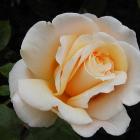It seems that people since time immemorial have enjoyed decorating their indoor spaces with cultivated plants. Even as far back as Ancient Egypt, banquet tables were graced with vases full of lotus flowers, roses, poppies and lilies.
A wide variety of decorative styles continue to inspire contemporary arrangements. Ikebana is a popular, elegantly simple Japanese style. Even today, traditional brides tend to choose romantic, sweet-smelling, Victorian-inspired bouquets.
A new modern style is also emerging, with centrepieces featuring plants of all kinds, including flowers, fruit, showy branches and even vegetables. The possibilities are practically endless – have fun and let your imagination run free.
Preparing your outdoor garden
All you need is a sunny space with good, fertile soil to have blooms you can bring indoors from spring to fall. First turn over the top six to eight inches of soil, rake it and remove any debris. Many different plants make excellent cut flowers. To see whether your favourite flower is a good candidate, just place it in water overnight and check to see whether the water level in the container goes down significantly by the next morning. If so, it’s a good choice.
Planning and planting
There’s no need to hide the flowers you grow for indoor use. Plant them as a hedge around your other landscaping or even around your vegetable garden. When you plant them, it is best to group them together by variety, with five plants in each group, instead of just one. If you have a lot of different colours in a small space, separate two bright colours with a neutral one, like a plant with white flowers or ornamental foliage.
Choosing your plants
Depending on how much space you have, try to choose plants that will give you blooms all season long. And match their colours with your interior décor, of course, because the idea here is to create a garden so that you can have indoor flower arrangements.
Long-stemmed flowers like tulips and zinnias are equally nice for borders and arrangements. Hostas, foxgloves and astilbes are usually used to add height to an arrangement. If you like “wild” or natural-looking flowers – ones that look like native wildflowers – use rudbeckias, veronicas, delphiniums, chrysanthemums or buddleias for their prolific blooms. Baby’s breath (Gypsophila) is a must, as it makes a good, airy addition to a bouquet. Roses are wonderful, but they require more care.
Perennials
In addition to annuals – which bloom for two to three months – you can plant perennials like blazing star, sunflowers and lady’s mantle. Don’t forget that grasses, which are lovely outdoors, add a warm, country touch to a flower arrangement.
Herbs
For even greater impact, many designers use herbs or foliage plants. Rosemary, sage, parsley and other herbs make great edging plants. Lavender, wormwood, lemon thyme and fennel are other attractive, pleasant-smelling additions. A few trailing species, like sweetpeas, clematis and runner beans, look lovely spilling over the edges of a container.
Fruit, vegetables, trees and shrubs
You can also use fruit, vegetables and even fungi in a flower arrangement, along with ornamental trees and shrubs. Fruit harvested in late fall adds special interest. A branch lined with cherry tomatoes at different stages of ripeness looks terrific in a vase with stems of parsley and basil. Small heads of ornamental cabbage (Brassica crispa) nestled into a bed of other ornamental plants with variegated foliage make another striking statement.
With a wide variety of spring bulbs, perennials, annuals and biennials, you will be able to create bouquets from April through to November. For interest during the cold winter months when you are unable to garden, plant some flowers that you can dry.
Based on an article by Édith Bienvenue in Quatre-Temps magazine, Vol. 16, No. 4.







